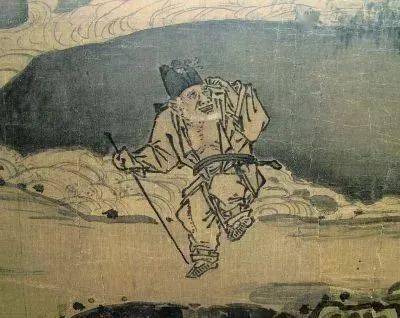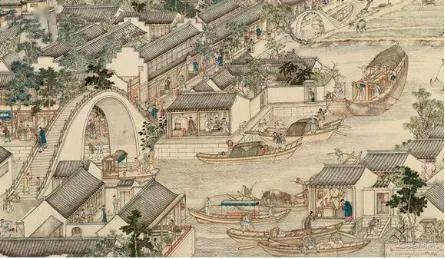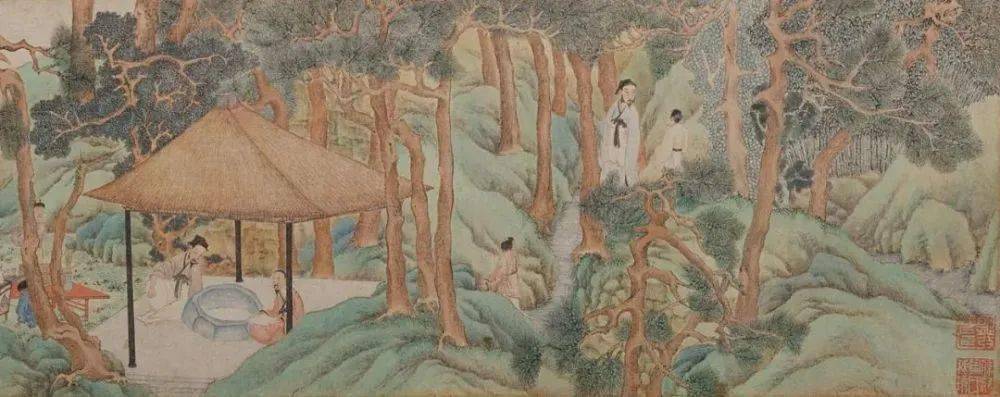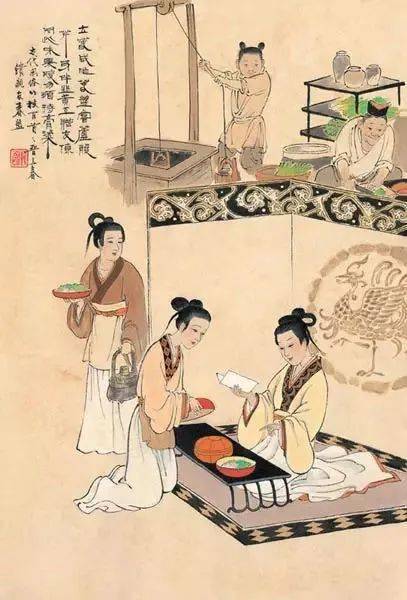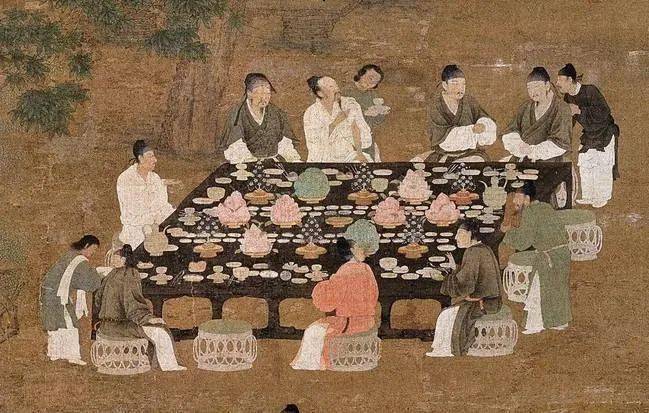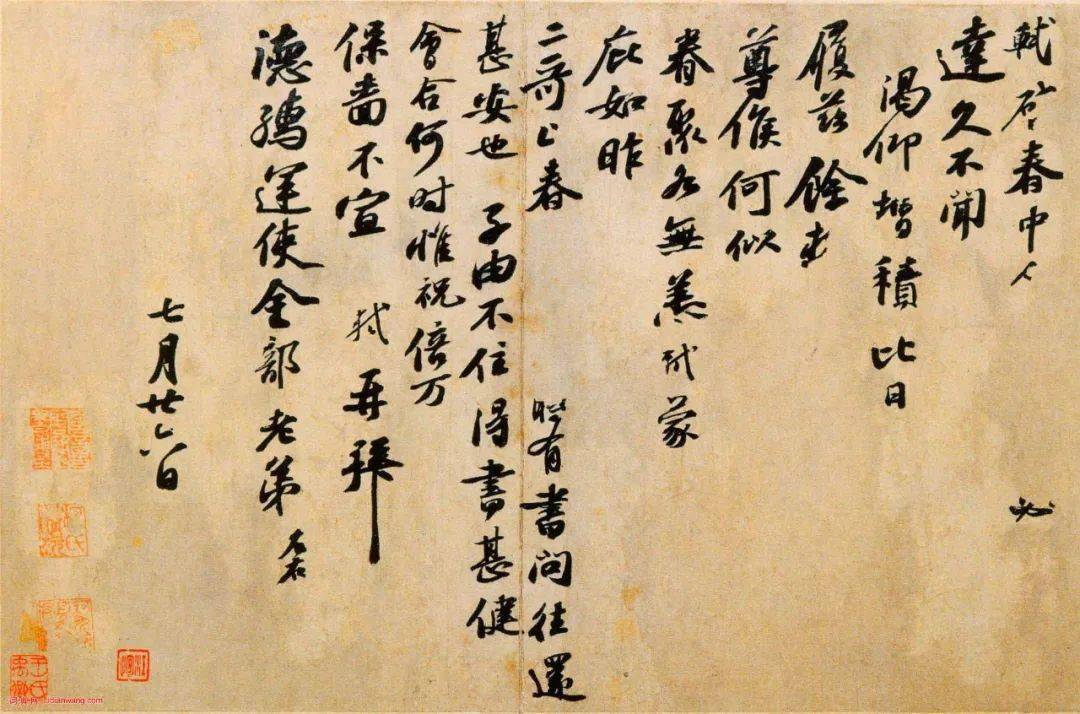古人春天食谱,引起极度舒适!What cuisine did ancient Chinese enjoy in spring? |
您所在的位置:网站首页 › 古代野味有哪些 › 古人春天食谱,引起极度舒适!What cuisine did ancient Chinese enjoy in spring? |
古人春天食谱,引起极度舒适!What cuisine did ancient Chinese enjoy in spring?
|
明戴进《春游晚归图》,台北故宫博物院藏 Returning Late From A Spring Outing by Dai Jin, Ming Dynasty, housed in Taipei Palace Museum 古时春季的其中一种“爆款”食材便是 芹菜。 One of the popular seasonal vegetable for spring in ancient times was celery. “鲜鲫银丝脍,香芹碧涧羹”——唐代“诗圣”杜甫爱的是用活鲜鲫鱼烹煮的 银色鱼肉丝,以及用芹菜、芝麻、茴香、盐等制成的羹。 Du Fu, one of the most famous poets in the Tang Dynasty, loved to treat himself with a thick soup cooked with shredded meat of crucian carp and celery, sesame, fennel and salt, according to one of his poems. 南宋文人林洪也是芹菜的绝对热衷者。 他在《山家清供》中记载,芹有二种,荻芹取根,赤芹取叶与茎。“二月、三月作羹时,采之洗净,入汤焯过,取出。……惟瀹而羹之者,既清而馨,犹碧涧然”——这里指的也是碧涧羹。 Another enthusiast of celery was Lin Hong, a scholar in the Southern Song Dynasty. According to one of his works, the edible part of celery varied depending on its species, and he also enjoyed the thick soup mentioned above. 林洪是进士出身,属于“文艺小清新”一派,强调山林之味,“自甘藜藿,不羡轻肥”。在《山家清供》中,林洪还写道,春季食趣在于 清鲜菜蔬的原味,爽爽清清,满目珠白碧翠。 比如,在仲春时节,古人还常采 百合根晒干,捣、筛、和面,做成 汤饼,“最益血气”。而百合面蒸熟了,还可以佐酒。 Lin preferred to preserve the original flavor of spring vegetables in the cooking process. Take lilies as an example. In mid-spring, lily roots were dried, mashed, sifted and kneaded to make flatbread which was believed to improve one's blood circulation and qi, or "vital energy". Steamed lily root noodles also went well with wine.
南宋马远《踏歌图》,故宫博物院藏 A Man Taps His Feet To The Beat of A Song , by Ma Yuan, Southern Song Dynasty, housed in the Palace Museum 韭菜也是春天必不可缺的应季食材之一。 在古代,春韭是 最应季的食物,做法也非常讲究。首先要把春韭理整齐,手拿着白色的韭菜梗在开水里稍微焯一下,去掉梗皮,然后用竹刀切好,放入锅中炒。炒到刚熟,就马上放进冷水里。这样再取出食用就会非常脆嫩。嫩韭菜用姜丝、酱油和醋拌起来吃,也是妙方,可以利小便、治尿潴留 。 Jiucai, or Chinese chives, was also a type of seasonal vegetable for springtime in ancient China. People would boil the Chinese chive buds, have the peel of the stem removed, cut the vegetable in lengths before frying them in a pot. When the vegetable was almost cooked, people would put them into cold water to make it taste tender and crisp. As for tender Chinese chive leaves, they would be served cold with shredded ginger, soy sauce and vinegar, which was believed to have good diuretic effects.
清徐扬《姑苏繁华图》(又称《盛世滋生图》),辽宁省博物馆藏 Flourishing City of Gusu by Xu Yang, Qing Dynasty, housed in Liaoning Provincial Museum 来自钱塘(今浙江杭州)的清代士大夫袁枚也对春天的食材研究有所涉猎。 在他的《随园食单》中,与春季有关的菜肴,是青青翠翠的,比如南京三月的“杨花菜”以及可用于腌制榨菜的台菜(芜菁)心。 他还写道:“富贵之人嗜素甚于嗜荤。”说明那时的富裕阶层已经知道茹素的种种好处,很符合现代的健康理念。 Yuan Mei, a renowned scholar-bureaucrat in the Qing Dynasty, had great interest in cooking materials as well. From his point of view, vegetables in springtime were mostly exuberantly green, such as stem mustard, the material for pickles, according to Recipes from the Garden of Contentment: Yuan Mei's Manual of Gastronomy ( Suiyuan Shidan 《随园食单》). He also noted that the rich tended to prefer vegetables more than meat, which coincides with people's healthy eating philosophy nowadays. 无独有偶,荆楚人士在春天的饮食习惯也是“绿色”的,他们每天采摘七种菜,做成羹汤来吃。 Likewise, residents of Jingchu area (the political, economic and cultural center of ancient Chu state, located in today's Hubei province), also enjoyed some sort of thick soup made with seven kinds of vegetables in spring.
五代周文矩《文苑图》故宫博物院藏 Literati Writing Poems Under A Pine Tree , by Zhou Wenju, Five Dynasties, housed in the Palace Museum 起源于晋代的 “春盘”则体现了春日 食材的丰富。晋代,人们“以萝菔(即萝卜)、芹芽为菜盘相馈”。 Abundance of food materials in spring in ancient China can also be spotted from some kinds of "plates" of vegetables popular among people in different dynasties. In the Jin Dynasty, the "spring plate" holding turnips and celery, was presented as gifts. 唐代,人们将生菜和春饼(常常用豆芽、菠菜、韭黄等炒成)、合为“春盘”。北宋的春盘,增加了蒿菜、韭菜等蔬菜种类,所以苏轼在诗里写道:“青蒿黄韭试春盘”。 While in the Tang Dynasty, such "plate" was served with lettuce and spring pancake, or "Chunbing", a delicacy made of bean sprouts, spinach, hotbed chives, etc. People in the Northern Song Dynasty, according to one of the poems written by Su Shi, a genius who excelled at poetry, cooking and travel in that era, had made the "plate" richer in content by adding vegetable categories like tarragon and Chinese chive leaves in it.
明文徵明《惠山茶会图卷》,故宫博物院藏 Huishan Tea Party by Wen Zhengming, Ming Dynasty, housed in the Palace Museum 与春盘类似的还有“五辛盘”,五辛即五种有辛辣味的蔬菜,一般是 大蒜、 小蒜、韭菜、芸苔、胡荽。传统养生学理论认为,五辛可以“发五脏气”,也就是疏通气血,有利于提高机体免疫力。诗云:“立春咸作春盘尝,芦菔芹芽伴韭黄。互赠友僚同此味,果腹勿须待膏粱。” Similar to the "sping plate" was "Wu Xin Pan (plate with five spicy vegetables)", which replaced all but Chinese chive leaves in the "spring plate" with spicy vegetables—garlic, wild garlic, brassica and coriander. The combination was believed to promote the flow of qi and blood circulation. The pungent portfolio was recommended to go with wine brewed out of Chinese citrus fruit, as what Meng Zhonghou, one of the dukes in the Northern Song Dynasty did. 五辛盘最好还要搭配黄柑酿的酒——北宋安定郡王孟忠厚用洞庭精品黄柑酿制成宫廷御酒,名曰“洞庭春色”。
王弘力(1927-2019)《中国古代风俗百图》一书中描绘的“馈春盘”——即品尝五辛盘。A painting portraying a Chinese dowager tasting the dish comprising five spicy vegetables, from a collection of paintings depicting Chinese ancient customs painted by Wang Hongli (1927-2019), a famous painter of serial pictures 古人还喜欢在春天品尝野菜,其中就包括了 莼菜、 荠菜和芦蒿。 Edible wild herbs were another must-have during spring for ancient Chinese.
宋徽宗以及宫廷画家共同创作的《文会图》,台北故宫博物院藏 An Elegant Party by the Emperor Huizong of Song and some other painters from the imperial court, Northern Song Dynasty, housed in Taipei Palace Museum 莼菜是水生野菜,多见于 江南水乡。中唐诗人严维《状江南》有云:“江南季春天,莼菜细如弦。”可见古人已经懂得在春天享用这道美食。 Water shield, a long-stemmed aquatic plant with floating oval leaves that resembles small water lily leaves but without a split, was commonly seen in Jiangnan area (the region south of the Yangtze River). According to Yan Wei, a poet in the Tang Dynasty, it was also a cuisine in spring. 更有甚者,有人竟然为了它甘愿舍弃仕途。 晋朝人张翰原本在洛阳做官,却十分思念家乡吴郡吴县(今江苏苏州市)的莼菜,于是索性辞了官归隐家乡,这就是“莼鲈之思”的典故。 The water shield was so tasty that an official even gave up his future only to savor it for good. The story later was turned into an idiom to describe one's homesickness. 宋代大诗人陆游则喜好荠菜,为此他还特地写过一首《食荠诗》:“小着盐醯滋美味,微加姜桂发精神,风炉饮钵穷家话,妙绝何曾肯受人。”诗人一碗荠菜配以作料,吃起来也趣味盎然。 Jicai, or shepherd's purse, is a kind of edible wild herb in spring, and was one of the favorites of Lu You, a prolific Chinese poet in the Song Dynasty. He even created a poem to praise the wonderful taste of jicai served with seasonings like fresh ginger and cinnamon.
明陈洪绶《品茶图》故宫博物院藏 Tea Time by Chen Hongshou, Ming Dynasty, housed in the Palace Museum 苏轼却对芦蒿(又名蒌蒿、藜蒿)情有独钟。1084年,被宋神宗派往河南汝州任职时,他特地取道今天的江苏南京品尝芦蒿,后来多次路过南京时, 只要有机会就去吃芦蒿,还曾赋诗云:“初闻蒌蒿美,初见新芽赤”“蒌蒿满地芦芽短,正是河豚欲上时。” Unlike Lu You, Su Shi had a craze for luhao, or water artemisia stems. In 1084, he took a detour specially to today's Nanjing city of Jiangsu province for the vegetable on his way to Ruzhou of Henan where he was assigned a new post by the Emperor Shenzong of the Song Dynasty. He also expressed his fondness of the edible wild herb in his poems, and would go taste the vegetable every single time he passed Nanjing.
北宋苏轼《春中帖》,故宫博物院藏 Work of Chinese calligraphy in running (行书, also called "semi-cursive ") by Su Shi, Northern Song Dynasty, housed in the Palace Museum 在江南地区, 五香糕也是一道春天美食。 Pastry is also not to be missed in the region south of the Yangtze River. 南宋浙西浦江人吴氏,是历史上鲜见的女性美食家,她撰写的饮食典籍《浦江吴氏中馈录》是中国现存最早的由女性作者撰写的菜谱。当中就记载了一款五香糕的方子:“上白糯米和梗米二、六分,芡实干一分,人参、白术、茯苓、砂仁总一分。磨极细,筛过,白砂糖滚汤拌匀,上甑。”在那个风雅精致的年代,泡一壶春茶,吃一口糕点,便是享受春天的标准仪式。 Lady Wu, a female gourmet from Pujiang of Zhejiang in the Southern Song Dynasty, compiled a collection of recipes called Pujiang Wushi Zhongkuilu (《浦江吴氏中馈录》), the earliest remaining works of its kind by a female author in China. In the book, a kind of pastry made of several ingredients such as sticky rice, gorgon fruit, ginseng, poria cocos and amomi fructus was recorded. Soaked in white granulated sugar, the snack was quite palatable to go with tea. 万物复苏的春天 往往伴随着令人击节的喜悦, 这当中自然离不开 食物的美妙“助攻”。 而从诗歌和典籍当中, 我们也了解了 前人对春日食材独特的料理之道, 在鲜少有机会亲近自然的今天, “品尝”一丝久违的仲春滋味。 In China, ancient people enjoyed spring by changing seasonal food materials into various delicacies. From poets and historical records, we can see how they cherished seasonal food and 'taste' a bit of their spring joy not quite familiar to many today as we are not that close to nature any more. 来源 ▏丝路云帆 本微信公众号法律顾问: 广东迅恒律师事务所 卢锐湘律师 ▼广东海丝馆 网上商场 ▼返回搜狐,查看更多 |
【本文地址】
今日新闻 |
推荐新闻 |
